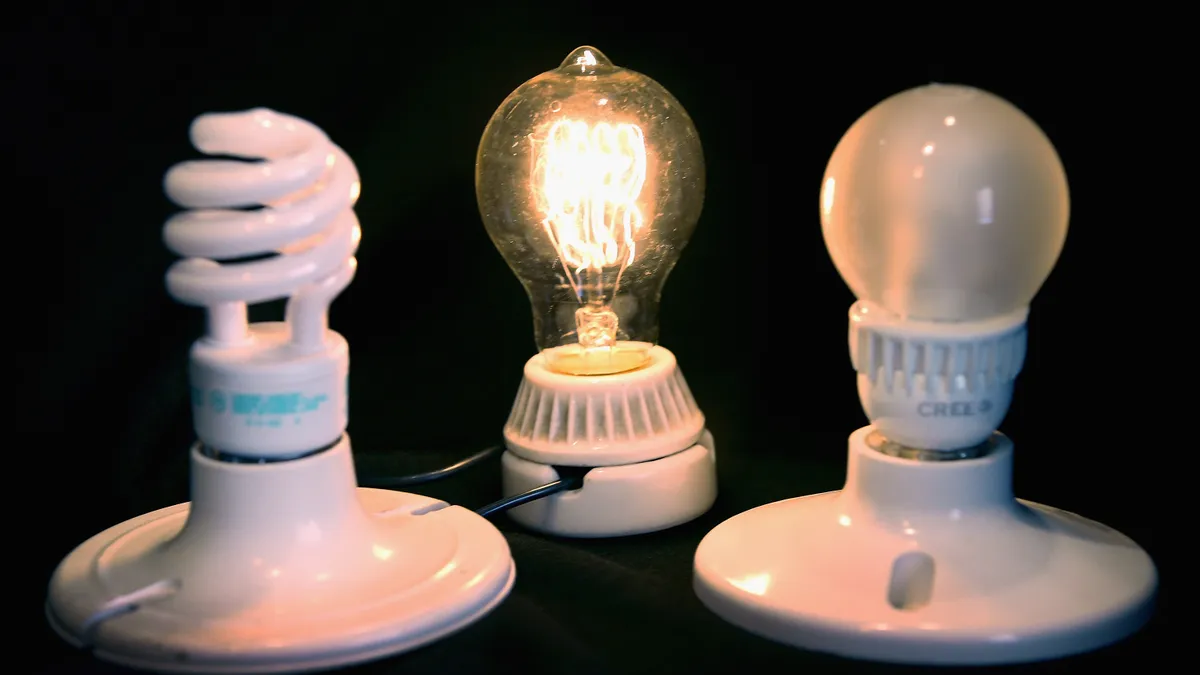Dive Brief:
- The U.S. Department of Energy (DOE) on Friday proposed energy efficiency requirements for the most common types of light bulbs, which conservation advocates believe will save consumers $300 million each month on their energy bills.
- The rule would codify a "backstop," or minimum efficacy standard, of 45 lumens per watt (lm/W) for general service lamps. DOE's notice of proposed rulemaking hints at a "staggered implementation" to ease the burden on manufacturers, leading the American Council for an Energy-Efficient Economy (ACEEE) to question whether the Biden administration is moving rapidly enough to combat climate change.
- DOE has also finalized a rule revising the agency's appliance test procedure interim waiver process, which under former President Donald Trump was altered to allow greater flexibility for product manufacturers. Efficiency advocates say those changes allowed inefficient appliances to remain on shelves longer than necessary.
Dive Insight:
ACEEE called the proposed light bulb rule a "major step," but also warned DOE is likely to miss an upcoming deadline to finalize the new standard.
"This progress is welcome news for consumers and for the planet, but the administration is not acting here with the urgency needed to address the climate crisis," ACEEE Executive Director Steven Nadel said in a statement.
In February, DOE indicated it would take action on several new efficiency rules finalized during the Trump administration which might present obstacles to meeting the United States' climate goals. The light bulb proposal will need to go through a 45-day comment period before it can be finalized, meaning the agency will miss a year-end deadline, said ACEEE.
DOE "needs to get this finalized and ensure compliance rapidly because every day manufacturers are making more energy-wasting bulbs for sale," Nadel said.
Light bulb manufacturers represented by the National Electrical Manufacturers Association (NEMA) have pressed for a gradual phaseout of less-efficient bulbs and previously recommended a two-year phaseout that "will be significantly less disruptive to manufacturers and retailers and will be far easier to manage" than a blanket sales ban on bulbs not meeting the backstop standard.
Should DOE finalize the 45 lm/W backstop, the agency in its proposed rule said it would "use its enforcement discretion to provide the necessary flexibility to avoid undue market disruption."
As part of a "discretionary enforcement approach," DOE said it would consider "a staggered implementation that weighs factors such as the point of manufacture."
DOE's rulemaking, "while not unexpected, falls far short on providing the needed certainty to retailers and manufacturers whose complex contract and planning needs demand adequate lead-times," NEMA Vice President of Government Relations Phil Squair said in a statement. "This is especially important in times of unprecedented logistics challenges, as we are now facing."
If DOE fails to provide certainty for lead-time planning, it "will cause hardship and financial impacts on domestic businesses and consumers," Squair said.
Under President Joe Biden, DOE has been working to reverse some changes made by the previous administration. In November, the agency finalized changes to the "process rule," removing hurdles that had been put in place in 2020 to setting appliance efficiency standards.
DOE also on Friday finalized rules that remove appliance efficiency provisions approved under the Trump administration that made it easier for manufacturers to receive waivers from product testing requirements.
"This helps ensure that all manufacturers’ products are as efficient as they’re required to be and no company can game the system," Andrew deLaski, executive director of the Appliance Standards Awareness Project, said in a statement. The group is based within ACEEE.
The testing waiver rule is "restoring a transparent and predictable procedure for ensuring all products are tested fairly and can compete on a level playing field," deLaski said.
The waiver process approved under Trump required DOE to make a decision on test waiver requests from appliance manufacturers within 45 days. If the agency failed to meet that deadline, a six-month waiver would automatically go into effect.
The new rule, according to deLaski, means DOE will return to reviewing all test procedure interim waiver applications, and make a best effort to respond within 90 days of a completed application.















